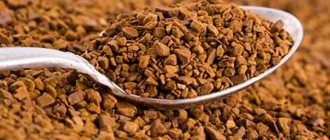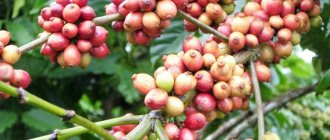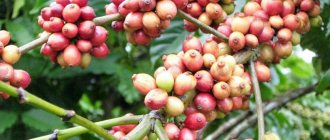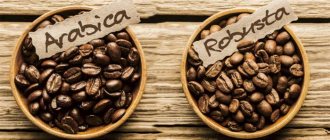Types of coffee
In total there are about 40 species of trees, and yet they vary greatly in external description. There are both shrubs and giants up to 7 meters high. But all types and varieties of coffee have been divided into four main groups, by which the type of drink is determined.
Each group has special properties, differences in grains and taste. It all depends on the place where the tree grows. The main factors of difference are soil and climate.
To obtain beans, mainly 4 types of coffee are used:
Arabica
This is the most popular type of Coffea Arabica or Arabian Coffee tree; its beans have a deep, complex bouquet of taste and aroma.
The plant is quite capricious and requires certain climatic conditions for cultivation - mountain plateaus or the slopes of volcanoes. It prefers climates with sharp temperature changes between day and night. The most serious enemy of Arabica is winter frosts. The annual harvest volume that can be obtained from one plant is 5 kg, from this amount no more than 1 kg of natural coffee beans is obtained.
From one tree per year, about 5 kg of green beans are obtained, after roasting which only 1 kg of finished coffee is obtained. The fruits ripen unevenly, after flowering they take about 9-10 months to grow and ripen. During this period, the tree requires watering, fertilizing and pesticide treatment against pests and diseases. The tree reproduces by seeds, which further complicates and lengthens the growing cycle.
Robusta
Trees of this species were first discovered in Africa in the Congo River basin. Robusta beans contain a lot of caffeine, so they make strong drinks.
Types of coffee drinks: photos with names and descriptions
Brazilian coffee beans are used to prepare a variety of drinks - both pure coffee drinks and those with the addition of milk, cream, syrups, ice cream, and alcohol. All drinks are prepared using strong espresso. Doppio is a double espresso.
To get another drink, you need to add the following ingredients to one part of espresso:
- Americano - two parts water;
- Cappuccino - one part hot and two parts frothed milk;
- Latte - two parts hot and one part whipped milk;
- Viennese style - two parts of whipped cream;
- Mochaccino - one part each of hot chocolate and whipped milk;
- Mocha - one part each of hot chocolate, milk and whipped cream.
A large assortment of coffee types allows you to choose the perfect drink for every day and combine the most unexpected tastes.
Growing regions
The range of coffee presented on the world market is indeed very wide. This is Arabic coffee, products from Africa, Vietnam, Jamaica. Brazil and Colombia have been considered the undisputed leaders in the market for many decades. In these countries, vast territories are occupied by Arabica and Robusta plantations, and grain exports constitute the main income of the state and its population.
Major global suppliers of coffee products
Coffee is produced in more than 50 countries around the world. Main importers of products:
- Brazil . The main varieties of coffee in the world are produced there. It imports 35% of coffee products, producing it using a dry processing method, and the quality of the drink then suffers.
- Vietnam . Over the past few years, it produces 20% of the world's coffee. Traditional exporters are Russia, Germany, Great Britain.
- Colombia . Produces the world's best Arabica coffee, which is known for its balanced taste.
- Mexico . It produces coffee in large volumes, but only the product that is grown on the mountain slopes is of interest. The rest is usually used in preparing mixtures.
- Nicaragua . Makes a strong drink with a sour taste, obtained after wet processing.
- Ethiopia . Varieties produced in the east of the country are known for their high acidity and winey taste, while those from the south have a bright, rich aroma and fruity taste.
- India . Produces monsoon green coffee with aromas of cardamom, nutmeg and cloves.
- Sumatra . The homeland of many varieties of drink with a bright taste and bitter smell.
In Russia, the prevalence of ground and bean coffee is constantly increasing, and in terms of the level of consumption of instant products, our country ranks first in the world ranking
More than 50 countries around the world grow coffee. But the most important producer of this finished product is Italy. Italian coffee is judged by its main drink - strong, aromatic and invigorating espresso. Many Italian brands have created a variety of special espresso blends so that every lover can prepare a delicious drink at home.
Geography of origin
The classification according to the geography of growing coffee trees is quite large. Plantations are located in more than 80 countries in Asia, Africa, Australia and America.
Australian
Coffee is in demand in the domestic market. It is grown in the east of the continent in northern Queensland on the Atherton Tablelands and south-west New South Wales.
Australian coffee grows in the subtropics at an altitude of 200 - 900 m above sea level.
The predominant varieties are Typica, Catay, Mondo Novo, and K7. In Australia, dry, wet and combined processing is used. A local company has developed the double pass method. The grains remain on the tree longer than usual. After collecting, they are immersed in water for 1 hour so that the shell becomes soft. At the same time, the sugar content in products increases by 20 - 30%.
Asian coffee
Traditionally, Indian, Yemeni, Indonesian and Vietnamese coffee are distinguished. The former grows in the districts of Maisery, Malabar, Coorg and Madras. Most of the plantations are occupied by robusta. The most common varieties are Kent, S795, SL9 and Kaveri.
In Yemen, Arabica is considered the most environmentally friendly in the world. The sites are located at elevations from 1000 to 2000 m on steep slopes. Elite varieties include Yemen Mocha Matari, Hodeidah and Sanani. In Indonesia, 90% robusta and 10% arabica are harvested. Famous plantations in Java are Blawan, Kayumas, Pankur and Jampit. In Sulawesi Thoraya, sweetness predominates, with nuts, fruits and maple syrup on the palate. In Sumatra, the varieties Ankola, Lintong and Mandeling grow in areas above 1000 m.
In the province of Aceh in northern Sumatra, coffee is grown, which is used in the Starbucks chain.
In Vietnam, coffee production is concentrated in the provinces of Dak Lak and the northern regions. Here they prefer to cultivate robusta (90%). Famous varieties include Blue Dragon and Sang Tao. Common types of Arabica are Bourbon and Catimor.
Arabica South America
Grains from Colombia, Brazil, Venezuela, Peru and Ecuador are valued on the world market.
The following coffee varieties grow in Colombia:
- Katura - grows at an altitude of 1500 m. There is no bitterness in it, but fruity notes are felt;
- Supremo is a thick drink with the taste of wine;
- Excelso - citrus fruits are clearly visible in the drink;
- Maragodzhip - characterized by a classic taste with cream and chocolate.
The Brazilian crop is used in mixtures for its medicinal flavor. A rare variety is Vilcabamba, which is produced in Ecuador. Peruvian coffee beans are popular in the domestic market.
Central America
In Costa Rica, coffee trees grow in the areas of Tres Rios, Alajuela and La Manita and Tarrazu. The latter variety is valued for its citrus aroma combined with milk chocolate. The prized Hawaiian Kona variety grows on the Mauna Loa and Hualalai volcanoes. In Guatemala, production is concentrated in Antigua, Fraijanes and Huehuetenango. The exclusive Blue Mountain grows on the slopes of the Blue Mountains in Jamaica. Often such grains are included in mixtures.
The Geisha variety from Panama is considered a favorite on the world market. The drink has an unusual taste, which is dominated by lime and berries.
African coffee
Africa is home to major coffee suppliers. The following brands of Arabica are grown here:
- Zambia Lupili;
- Malawi Mapanga;
- Uganda Bugishu;
- Sidamo;
- Jammah.
Kenyan plantations are located at 2000 m above sea level. Ethiopia is the only country where Arabica grows in semi-wild conditions. Arabica beans from Zambia are large in size.
Coffee classification
It is very difficult to say with complete confidence how many varieties there are in the world today. The assortment of coffee is wide, because the product is classified according to many criteria; accordingly, the beans differ in taste, richness of aroma and price. The names of coffee varieties are determined by the following criteria:
- Country of Origin;
- by the name of the port from where the product is transported;
- by type of tree;
- by the name of the plantation where the trees are grown;
- by the name of the specific geographical point where the plants are grown;
- in accordance with the international classification;
- commercial name.
By quality
According to the process of preparing raw materials, products are labeled as follows: European preparation (EP) according to the European method (involves the elimination of 8 defects per 300 grams of grain), American preparation (AP) - the American method with the removal of no more than 23 defects per 300 grams.
- elite coffee varieties are marked AA and A;
- good coffee – AB marking;
- grains of medium quality - markings B and BA;
- Low quality grains - marked BB and C.
By geographical location
- grains from mountainous areas - SHG (Striktly High Grown);
- grains grown in the foothills - HG (High Grown);
- grains grown on flat terrain - CS (Central Standard);
- very hard grains - SHB (Strictly Hard Bean);
- hard grains - HB (Hard Bean).
By strength
The strength of coffee depends on how much caffeine it contains. This indicator is also influenced by the following factors:
- Type, variety and region of cultivation . Robusta produces a stronger drink than Arabica. The strongest coffee is made in Africa and the Arabian Peninsula.
- Roasting degree . The strength of the drink reaches its maximum with dark roasting.
- Cooking method . To get an invigorating drink, you need to add more ground grains.
- Cooking method . The longer coffee is brewed, the stronger it becomes.
According to the grain processing process
- AP (American preparation) - preparation according to the American method - no more than 23 defects are removed from every 300 grams of raw materials;
- EP (European preparation) - preparation according to European methods - no more than 8 defects are removed from every 300 grams of raw materials.
According to the age
According to the degree of freshness of coffee beans, the product is divided into two main categories: New crop and Old crop . The first category includes fresh grains that have been packaged immediately after harvesting and processing. The second group includes last year's harvest, from which there are unsold leftovers.
Another classification option involves the presence of age levels such as Mature (Old) and Vintage coffee (Aged coffee). The first point includes grains that have been stored for 1-3 years in special warehouses, and the second includes those that have been stored for 4-10 years.
By grinding degree
There is an opinion that strong natural coffee must have a bitterness. The palette of coffee flavors completely debunks this myth: most blends are created with a high Arabica content, which eliminates the bitter aftertaste even with heavy roasting.
| Grinding | English name | Peculiarity | Extraction time (drink preparation speed) |
| Rude | Coarse grind | Used for preparation in a piston type coffee maker | 6 to 8 minutes |
| Average | Medium grind | Coffee of this grind is considered universal, the raw materials are suitable for preparing any drinks and by any means. | 4 to 6 minutes |
| Thin | Fine grind | Used in filter coffee makers | 1 to 4 minutes |
| Fine espresso | Fine espresso grind | Used in espresso coffee makers | No more than 4 minutes |
| Powdery | Pulverized | This grinding powder is suitable for making Turkish coffee | 7 to 10 minutes |
Different types of coffee may not have the same characteristics. The aromatic drink is selected individually, taking into account your taste preferences. What type of coffee is the most delicious? Even fastidious coffee lovers will not answer this question the same way.
Considering the large number of additives, you can choose an inexpensive type of coffee and enjoy interesting cocktails with the whole family. Others will think that there is no such thing as expensive bad coffee, and will spend a lot of money on their own whim.
By grain size and shape
Grains are sorted by size taking into account the following gradation - from very small grains, the size of which is 4.8 millimeters, to very large grains, measuring more than 8 millimeters. There are a dozen of these sizes in total.
Arabica beans are more oval in shape, Robusta beans are more round. The classification of beans in world coffee production is called screening
(essentially, selection by sifting). The length of Arabica beans ranges from 6 to 15 millimeters; Robusta grain length is from 4 to 9 millimeters.
Caffeine content in beans
The caffeine content in Robusta beans is higher than the content of this substance in Arabica beans - almost twice
. Thanks to this fact, robusta beans are used not only as the basis of coffee drinks, but also for medicinal purposes.
Defects in coffee beans
TABLE Coffee beans and their defects
If you are dealing with high quality coffee with minor defects, use 300 grams.
Lower quality coffee with many defects is referred to as low-grade and substandard coffee. The coffee is then roasted and brewed to evaluate the characteristics of the resulting cup.
Primary defects in green coffee beans
Secondary defects in green coffee beans
According to the SCAA method, green coffee is sorted into five quality levels:
Specialty Green Coffee (1) : Specialty green coffee beans have no more than 5 total defects in 300 grams of coffee. Primary defects are not allowed. A maximum of 5% above or below the specified screen size is allowed.
Specialty coffee must have at least one distinguishing characteristic in body, taste, aroma or acidity. Should not have any shortcomings or defects. Quakers are not allowed. The moisture content should be 9-13%.
Premium quality coffee (2) : Premium coffee must have no more than 8 total defects per 300 grams. Primary defects are allowed. A maximum of 5% above or below the specified screen size is allowed. Must have at least one distinctive characteristic in body, taste, aroma or acidity. Must not be flawed and can only contain 3 Quakers. The moisture content is 9-13%.
Exchange grade (3) : The exchange grade must have no more than 9-23 total defects per 300 grams. It must be 50% above screen size 15, but must not exceed 5% below screen number 14. There are no errors in the cup and a maximum of 5 quakers is allowed. The moisture content is 9-13%.
Low-grade coffee (4) : 24-86 defects per 300 grams.
Substandard coffee (5) : more than 86 defects per 300 grams. Below is a table for grading coffee beans. It is based on the main defect and the number of defective coffee beans.
Elite varieties
High-quality coffee beans cannot be cheap - true admirers of natural drinks know this. The market has formed a rating of the best manufacturers who care about the high quality of all types of grains and packaging for their storage:
- large Arabica Maragogype from South America (also grown in Nicaragua and Mexico);
- Guatemala Lagos Shb is spicy in taste with an interesting smoky aroma;
- Bourbon Arabica El Salvador Chalatenango with a soft almond hue;
- pure Mocha S >You won’t find expensive (elite) types of beans on the shelves of regular supermarkets. They can only be ordered from catalogs or specialized online stores.
What types of elite coffee are there? The best of them are described below.
Jamaica Blue Mountain is one of the leaders among elite varieties. The beans of this variety have a blue-turquoise hue. The grains are very aromatic, giving the drink a nutty flavor. The drink is too versatile in terms of aftertaste and has good acidity. Due to the fact that the bulk of this rare coffee is purchased by Japan, it is impossible for the average coffee lover to purchase it on the market.
Kopi Luwak is considered one of the most expensive. Produced in Indonesia. A local rodent, nicknamed luwak, is directly involved in its production. It eats ripe coffee beans, and from its feces, partially digested coffee beans are extracted, which are roasted and ground to create a gourmet drink.
Old Java is the so-called aged coffee. It is obtained after 6 years of storing grains under certain conditions. The drink obtained from them has a thick consistency and unusual aroma.
Coffee varieties are a very broad concept. It is difficult to describe their exact number, but we were able to describe the majority of those on the market in this article.
Exotic coffees
For a long time, Kopi Luwak was considered the most expensive and exotic type of coffee. The luwak grains processed in the stomach of the animal got rid of natural bitterness and acquired an interesting chocolate flavor. The aromatic variety of coffee is obtained without the involvement of breeders and the latest technologies - the animal eats only the ripe, best fruits. Price – from 400 to 1000 $/kg.
There is a cheaper version of a rare variety of coffee - Monkey Coffee, obtained by Taiwanese farmers. The technology is similar to the first type, but Formosan monkeys are used to process the grains. This significantly reduced the price to $45-50/kg. The finished drink has a pronounced vanilla flavor.
Producing countries
About 80 countries around the world grow coffee trees on their territory. 70% of them are Arabica. The rest of the volume is robusta. In Vietnam, for example, delicate Arabica does not take root, so farmers started growing Robusta and succeeded in it. Vietnamese varieties taste very good, as they were crossed with Arabica to enhance immunity.
Brazil is one of the largest suppliers of coffee to the market. Here, according to the international classification of coffee, inexpensive varieties are grown and used for blending.
South America - Ecuador, Peru, Colombia, Chile, Venezuela - also produces a lot of raw coffee, the pre-sale preparation of which is carried out in Europe and North America.
Expensive varieties are grown in Central America. These are Honduras, Guatemala, Costa Rica, Nicaragua, Jamaica.
Among the Asian countries the leaders are: India, Vietnam, Indonesian islands, Yemen. On the African continent, the natural taste has been preserved by grains grown in Ethiopia. Kenya and Uganda supply expensive beans with a distinct flavor.
The most popular varieties in the world
Australian
The most popular is Arabica Australia Skyberry. This variety appeared in the world relatively recently, but has already won the love of gourmets all over the world, because its qualities are in many ways reminiscent of the favorite, expensive drink of the British royal family - Jamaican Blue Mountain. Taste characteristics – soft taste with a tart note.
Asiatic
- Arabica Yemen Mocha Mattari. For many centuries, the real wealth of Yemen was considered to be spices, incense and a special type of coffee - mattari mocha. The name of the product comes from the area where the plants are grown. It was this variety that first appeared on the territory of Russia and European monarchs drank it with pleasure, for which the drink began to be called “coffee of the lords.” Mocha has unique taste qualities - it can be easily recognized by its light sourness and pleasant chocolate aftertaste. This is one of the most popular single-origin coffees.
- Robusta India Cherry. This variety of Robusta has an incredibly rich aroma and a rather bitter taste with a slight sourness. It is not used as a single variety, but is often added to coffee blends.
Note: the following varieties are very popular - Arabica India Monsund Malabar, the most expensive coffee is recognized as Arabica Indonesia Kopi Luwak, another variation of the famous Blue Mountain - Arabica Papua New Guinea RV.
Arabica South America
- Brazil Santos (Arabica Brazil Santos). The drink has a rich, rather strong taste with a slight sourness and a hint of spice. If you don’t like exotic coffee, but prefer classic coffee, choose this variety.
- Colombia Supremo. The name means magnificent. The drink fully justifies its title - delicate, velvety taste, slightly sweet with a slight wine sourness.
Central America
- Arabica Guatemala Maragogype. It has a spicy taste and a slightly smoky aroma. The drink is valued for its richness and rich flavor bouquet with floral and fruity notes.
- Arabica Guatemala Antigua. It is distinguished by characteristic bitterness and notes of prunes, the aftertaste is light, citrusy with spicy chocolate notes. This variety is chosen by gourmets from different continents.
African
The most popular Arabica varieties are:
- Burundi AA (Arabica Burundi AA);
- Kenya (Arabica Kenya);
- Ethiopia Sidamo (Arabica Ethiopia Sidamo).
Considering that coffee is grown on many continents, we can say with confidence that there are as many varieties of this magnificent drink as there are tastes.
We recommend reading about the cultivation and varieties of Indian coffee, as well as in more detail about the differences between Arabica and Robusta.
Rating of the best types of coffee
This is not to say that the main varieties of coffee are grown only in one place. Different countries have their own characteristics for caring for trees, thanks to which the grains acquire their own special taste.
The list is very large, it is not even possible to say exactly how many varieties of coffee exist in the world; breeders are looking for new qualities for the plant every day. In addition, to determine the type, there is a strict classification based on grain size. The names and characteristics of the most famous are given below.
There are a great many varieties, but the leading positions are invariably occupied by the following varieties:
Brazilian bourbon santos
This is the most common type of coffee. Grown in Brazil, the bourbon has a chocolate flavor with a hint of almond and citrusy acidity. It is these qualities that give him high recognition in the world.
Maragogyp
This coffee variety is known not only for its sweetness, but also for the size of the beans grown, and the drink is thick and aromatic. The most famous plantations are located in Guatemala, Mexico and Brazil.
Medellin
The quality of the beans of this variety is on the lips of lovers every year. Careful collection and detailed sorting prevent bad seeds from being exported. Colombian producers carefully ensure that only even and smooth fruits are exported.
Colombia Excelso
The peculiarity of the variety will be a bright cocoa flavor and mild bitterness. There is a slight sourness.
Maracaibo
Venezuelan Maracaibo is not inferior in quality even to varieties from Colombia. Possessing notes of dry wine, it has no analogues throughout the world, which is highly prized at auctions.
Oksaka
The homeland of this variety is Mexico. The coffee has a well-defined flavor of vanilla and nuts, with a slight bitterness.
Antigua and Cobano
Both varieties are native to Guatemala. Many connoisseurs love their invigorating strength and pleasant sourness.
El Salvador Jalatenango
The floral aroma and almond flavor give the drink a certain sophistication. This is why the Brazilian variety is known throughout the world.
Ethiopia Mocha
The Mocha coffee variety can rightfully be considered one of the best. For its very well-defined wine-fruit flavor and apple-coffee aftertaste, Ethiopia Mocha Sidamo easily became popular among connoisseurs.
Yemen Moha
The variety, grown on the slopes of Yemen's volcanoes, has a sweet fruity aroma and constant acidity.
From the names you can see that first of all they represent the country in which they were grown, becoming the main source of income and a national treasure.
Types of coffee drinks: range and names
Arabica has more than 40 varieties, which differ in taste, smell, strength, richness, thickness of the drink and foam. The most popular types of drink:
- Santos. A Brazilian variety made from Moroccan mocha, it is considered the world standard in the coffee industry. Production is established in Sao Paulo.
- Bourbon Santos. The drink combines softness and strength of taste, rich aroma and a slight sour aftertaste.
- Flat Bit Santos. It has a spicy aroma, nutty notes in taste and sufficient softness, despite the strength of the drink.
Among the varieties of Robusta, the conilon variety stands out. It has a distinct bitter taste and is ideal for making espresso. Conilone is typically used for blending with Arabica beans.
How to choose coffee beans
A barista or an experienced coffee shop consultant will tell you how to choose bean coffee and what variety to take. To enjoy the unique aroma and wonderful aftertaste every day, you need to choose the right variety.
A few simple recommendations will help you choose the right coffee beans yourself:
- It is better to make purchases at specialized points of sale. As a rule, there is a large assortment and experienced sellers.
- It is worth feeling the packaging carefully - the grains must be intact in order to retain their properties. Smell the pack: it should not have a rotten or sour smell. It is better to give preference to a product whose packaging has a transparent window - this way you can visually assess the quality of the beans inside the pack. The packaging must be sealed to prevent air from getting inside.
- Don’t forget to read the contents of the coffee label; it should indicate the variety, degree of roasting, and the presence of flavorings.
- Remember: a good quality drink cannot be cheap. The price of coffee per 100 grams should be high. If you are in doubt about the choice, there is always the option of buying beans by weight; such coffee will be inexpensive. Only in order for the grains to retain their quality, the packaging must be tightly closed.
Why does coffee sour?
Sometimes a prepared drink has a sour taste, and an unprepared person may think that it is spoiled, which is completely wrong. He probably just hasn’t come across the concept of sourness in coffee yet.
This is a mandatory property of all Arabica beans: the higher the trees grow, the more sour the drink from the beans will be. Robusta does not have this quality.
In addition, the taste of the drink depends on the degree of roasting. If the beans are lightly roasted, then the coffee will definitely be sour, and if the beans have acquired a black tint, then in most cases it will not be sour, but will rather be bitter.
Sorting coffee beans
Grade 1: Special grade coffee beans: no primary defects, 0–3 total defects, graded to a maximum size of 5% above and 5% below a specific screen size or range of screen sizes, and exhibit a distinctive attribute in one or more of the following: flavor , acidity, body or aroma. There should also be no defects or damage to the cup. There should be no Quakers. Moisture content between 9-13%.
2nd grade: premium coffee beans: the same characteristics as 1st grade, with the exception of a maximum of 3 quakers. 0-8 total defects.
3rd grade: exchange coffee beans: 50% above sieve number 15 and less than 5% below sieve number 15. Maximum of 5 quakers. There should be no mistakes. 9-23 total defects.
Grade 4: Standard grades of coffee beans: 24-86 total defects.
Grade 5: low-quality coffee beans: more than 86 complete defects.
Organic coffee
Organic coffee is perhaps one of the healthiest drinks available and is grown without the use of chemical additives or external soil amendments.
Naturally, it still contains caffeine, which is harmful to the body, but if you use moderation, organic coffee only improves the functioning of the digestive tract and cardiovascular system. They create organics from Arabica and Robusta.
The world of coffee is very wide and diverse; even a connoisseur sometimes does not immediately understand the numerous types of this noble drink. But at the same time, coffee is worth knowing and loving, because it contains all the taste of hot southern countries and high fertile mountains.
Coffee bean price
The boost of energy and pleasure from a cup of coffee beans directly depends on the quality. On the package they write what characteristics the prepared drink has. To save money, you need to purchase a large pack in an online store: to do this, you need to select from the catalog and order on the website. You can then receive it by courier or by mail, delivery is fast and takes from 3 to 5 days.
The price of coffee beans is not the same. The cost consists of many factors, the main ones being brand, manufacturer, composition. A small table will help you figure out how many rubles you will need to pay for a pack weighing 1 kg.
By type of grain processing
After harvesting, primary processing is carried out. Depending on the characteristics of the process, there are 2 methods.
Wet
The harvest is washed and soaked for some time in water. After this, it is washed again with water and sent to dry. As a result of exposure to moisture, fermentation occurs, which makes the fruit soft and elastic.
Dry
This method is suitable for sunny areas. The harvest is dried naturally in air. The coffee is sifted to remove any remaining pulp. Thanks to dry processing, the drink has a sharper and more expressive taste.











